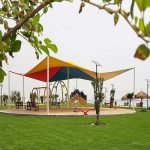Given Qatar’s desert landscape, it’s no surprise that the country experiences some of the most extreme summers on record, with temperatures often soaring to 50 degrees Celsius. Despite the intense heat, Qataris have adapted well to these conditions over the years. Below is a comprehensive overview of Qatar’s regional climate, including information on its various seasons.
Climate of Qatar
Qatar boasts a consistent climate across its entire territory. Due to its flat, arid landscape, the country is spared from erratic or unusual weather patterns. However, the northern region of the country typically experiences rainfall earlier than other areas. Qatar’s extensive 560-kilometer coastline also means that coastal cities tend to have higher humidity levels than inland areas.
Coolest and hottest months in Qatar
In Qatar, January is typically the coolest month of the year, with an average daytime temperature of around 21.5 degrees Celsius and nighttime temperatures dropping as low as 13.5 degrees Celsius. These temperatures are largely influenced by the country’s coastal regions.
Qatar’s hot season begins in April and lasts until October, with the hottest period falling between May and mid-October. March and October serve as transitional periods between the end of winter and the start of summer, respectively.
The sun shines all year-round in Qatar, and the country experiences up to 14 hours of daylight from May until August. In winter, the daylight lasts around 10 hours.
Rainfall in Qatar
Qatar receives very little rainfall, with a monthly average of only 5.9 mm. Rainfall typically occurs occasionally in March, April, and May, while June to October is considered the country’s dry season, during which rainfall is rare. Although rainfall is usually brief, occasional showers can cause dry river beds to fill up, and in rare cases, flooding may occur.
Seasons in Qatar
While Qatar’s seasons are primarily classified into summer and winter, there are also some notable differences that allow for the recognition of spring and autumn months.
Summer Season
From June to August, Qatar experiences scorching temperatures that can range anywhere between 45-50 degrees Celsius, with nighttime temperatures hovering around 29-30 degrees Celsius. Humidity levels during this period can reach between 40-60%. Fortunately, most buildings and apartments in Qatar are fully air-conditioned, so you don’t have to worry about enduring the heat all day, every day.
Winter Season
Qatar’s winter season lasts from December to February, during which daytime temperatures typically reach around 24 degrees Celsius, while nighttime temperatures drop to a pleasant 18-19 degrees Celsius. Thanks to the cool desert breeze, temperatures may even dip lower. This is an ideal time for desert activities and camping trips with family members. However, with the temperatures dropping at night, it is advisable to carry warm clothes, blankets, and cardigans to stay comfortable.
Spring Season
Following the winter season, Qatar experiences a warm climate from March, signaling the arrival of spring. This is an excellent time to enjoy outdoor activities during both the day and night, such as kitesurfing, jet skiing, exploring the mangroves at Purple Island, or going kayaking or paddleboarding.
Here’s all that you have to know about visiting Purple Island.
Autumn Season
Autumn in Qatar typically begins in September, although temperatures do not drop significantly during this period. Days can still feel warm but not as intense. Humidity levels are around 60-70%, and you may experience sudden hailstorms and windy days.
During autumn, you can enjoy the breezy evenings at the Corniche, Souq Waqif, go for a walk around Katara Cultural Village or have a nice picnic at Aspire Park.
Here are few of the parks you can visit in Qatar.
Please Subscribe Us to get updated with Qatar News, Saudi News, Kuwait News, Health News, UAE News, Iqama, Visa, Jobs, Banking and More..



